Stakeholder Navigator
- Browser
- iPad
The Stakeholder Navigator enables users to create and execute a successful account management strategy by illustrating the makeup of an account and highlighting important people related to the account—for example, KOLs or influential HCPs. The Stakeholder Navigator provides a visualization of the general structure and relationship between accounts to help users understand the makeup of an account.
For example, Sarah Jones is a Key Account Manager (KAM) with a new key account to cover. She uses the Stakeholder Navigator to get an idea of who the key stakeholders are within the account, and what relationships they have to other people in the organization, so she can use that information to understand who to target as a part of the account plan.
Configuring Stakeholder Navigator
Ensure initial configuration is complete before enabling this functionality.
To enable Stakeholder Navigator for the CRM Browser platform:
-
Configure the following permissions for the user. (Affiliation_vod permissions are not required. Stakeholder Navigator will run without allowing the user to view & modify affiliations in the hierarchy.)
Object OLS Record Types Fields FLS Account
R
n/a
- Account_Identifier_vod
- ID_vod
- Formatted_Name_vod
- Primary_Parent_vod
read
Affiliation_vod
R
n/a
- From_Account_vod
- To_Account_vod
read
Child_Account_vod
R
n/a
- Child_Account_vod
- Parent_Account_vod
read
- Enable the following Apex Class:
- StakeholderNavigatorController
- Add the Stakeholder_Navigator_vod action to the Salesforce Mobile and Lightning Experience Action section of the appropriate Account or Account_Plan_vod page layouts.
To enable Stakeholder Navigator on iPad:
- Ensure Accounts is configured for all appropriate users.
-
Configure the following permissions for the user. (Affiliation_vod permissions are not required. Stakeholder Navigator will run without allowing the user to view & modify affiliations in the hierarchy.)
Object OLS Record Types Fields FLS Account
R
all
- ID_vod
- Formatted_Name_vod
- Account_Identifier_vod
- Primary_Parent_vod
read
Affiliation_vod
R
n/a
- From_Account_vod
- To_Account_vod
read
Child_Account_vod
R
n/a
- Child_Account_vod
- Child_Record_Type_vod
- Parent_Account_vod
- Parent_Record_Type_vod
read
To create, edit, or delete affiliations in addition to viewing them, users need CRUD access on the Affiliation_vod object.
-
Verify that the following Veeva Settings are populated with the appropriate Veeva Message:
- Stakeholder Navigator Account Types - STAKEHOLDER_NAVIGATOR_ACCT_TYPES;;STAKEHOLDER_NAVIGATOR
- Stakeholder Navigator Account Plan Types - STAKEHOLDER_NAVIGATOR_ACCT_PLAN_TYPES;;STAKEHOLDER_NAVIGATOR
- Populate the Veeva Messages with the names of the record types where Stakeholder Navigator should display:
- For Account record types - STAKEHOLDER_NAVIGATOR_ACCT_TYPES;;STAKEHOLDER_NAVIGATOR
- For Account Plan record types - STAKEHOLDER_NAVIGATOR_ACCT_PLAN_TYPES;;STAKEHOLDER_NAVIGATOR
Record types in the Veeva Message must be specified by Record Type Name. For multiple record types, use a list delimited by single semicolons. For example:
- Hospital_vod;Professional_vod;KOL_vod
- Populate the Enable Global Account Search setting in Global Account Search Settings with a value of 1 to display the Add to Territory option in Stakeholder Navigator. This allows iPad users to add an out-of-territory account to one of their assigned territories.
(Optional.)
This step is only necessary for iPad users; it is not needed for users on the CRM Browser platform.
- Grant all users access to the VeevaGlobalAccountSearchController Apex class.
- Enable the appropriate VMOCs for the Global_Account_Search_Settings_vod object.
Using the Stakeholder Navigator
To view the Stakeholder Navigator, select the Stakeholder Navigator button on an account or an account plan. The account Stakeholder Navigator is launched from is the root account. If the root account is a parent account, users can expand the hierarchy to display child accounts.
Exploring the Stakeholder Navigator
Using the set of buttons on the left of the Stakeholder Navigator, users can do the following:
- Display Full Hierarchy
- Zoom In (online only)
- Zoom Out (online only)



Users can zoom in and out on iOS devices using pinch-to-zoom. The buttons do not display in iOS devices.
Users can also drag the hierarchy on the screen to focus on a particular section.
Loading the Hierarchy
To enhance performance, either one or two levels of the hierarchy load by default on the Stakeholder Navigator. Each level displays the child accounts for a parent account in the hierarchy. For example, if Newton Memorial Health is the root account, or the account from which the Stakeholder Navigator was opened, and has four child accounts, those four accounts are the first level. The child accounts of the first level comprise the second level of accounts.
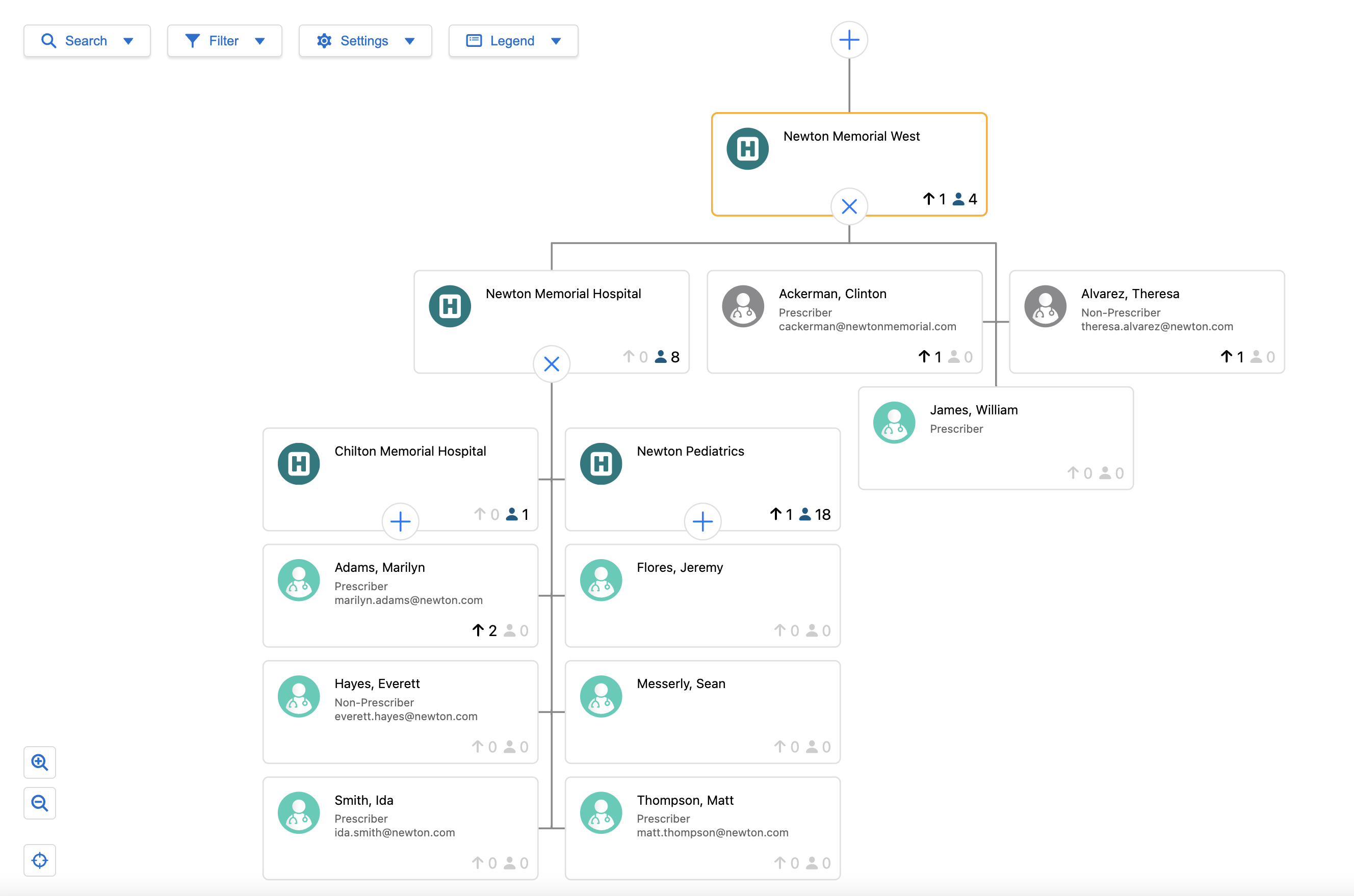
- For parent accounts with fewer than 500 child accounts, two levels of child accounts load
- For parent accounts with more than 500 child accounts, the first level of child accounts loads. Users can open more levels as needed.
If a child account has more than one parent account, Stakeholder Navigator displays the primary parent. If no primary parent is designated, Stakeholder Navigator displays the parent who's name is first alphabetically.
Account Cards
Each account card in the Stakeholder Navigator displays the record type icon and the name of the account. Account Identifiers are also shown and can be customized. The number of affiliations and child accounts are shown on the bottom right corner.
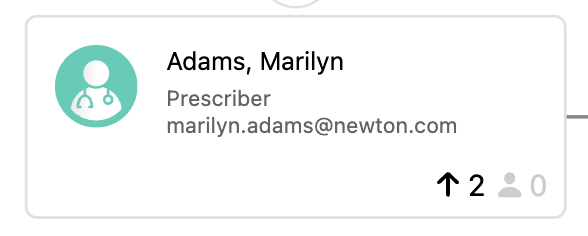
- Expand - A plus button displays on account cards when there are unloaded children that can be shown in the hierarchy.
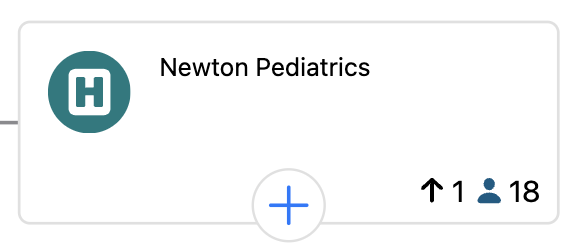
- Collapse - An X button displays on account cards when there are child accounts that can be collapsed.
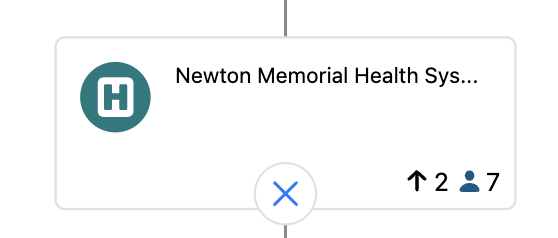
- Show More - A plus button is also used to indicate that more child accounts are available to display for a parent account. The first ten child accounts display initially, and selecting the plus button shows up to ten more child accounts at a time.
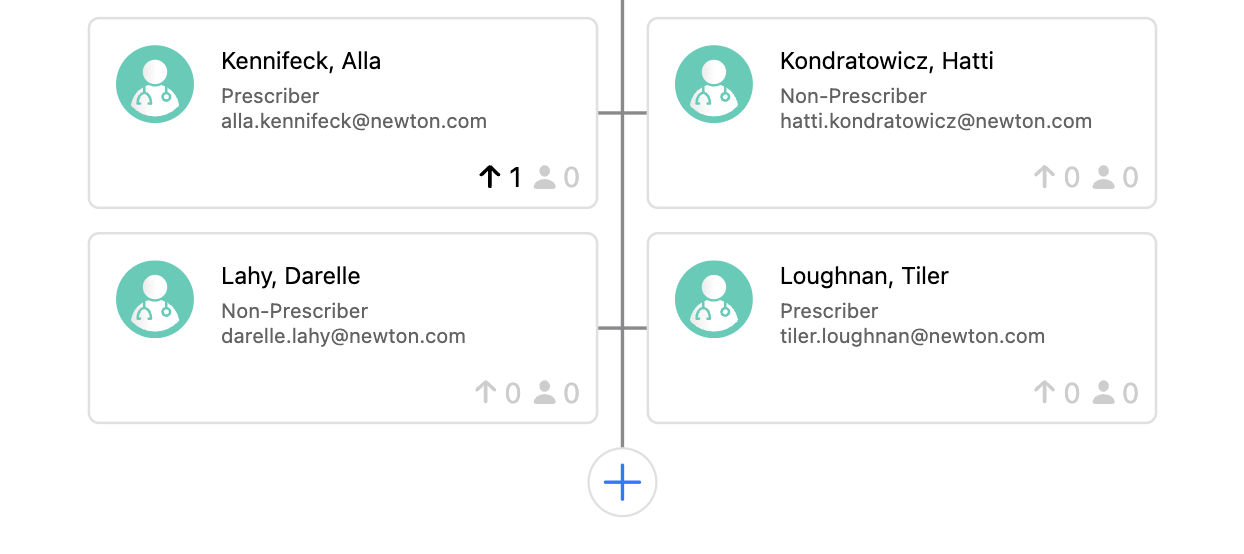
- Load Parent Accounts - A plus button above the root of the hierarchy indicates that the root account has an unloaded parent account. Selecting the plus button loads the root’s parent and sibling accounts.
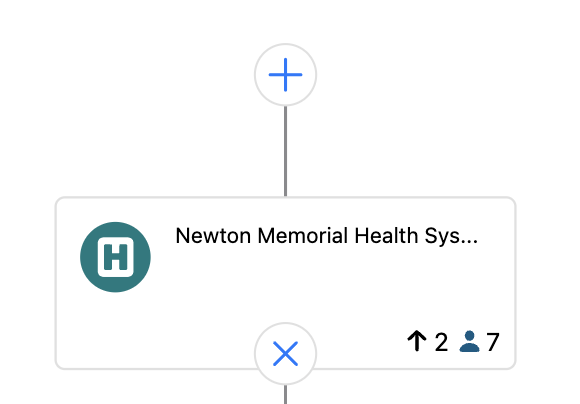
Account Modal
When a user selects an account card in the hierarchy an account modal appears with 3 tabs.
- Info - This tab displays information relevant to the selected account. The displayed fields can be customized. The user can also navigate to the account’s detail page and timeline as well as create new affiliations.
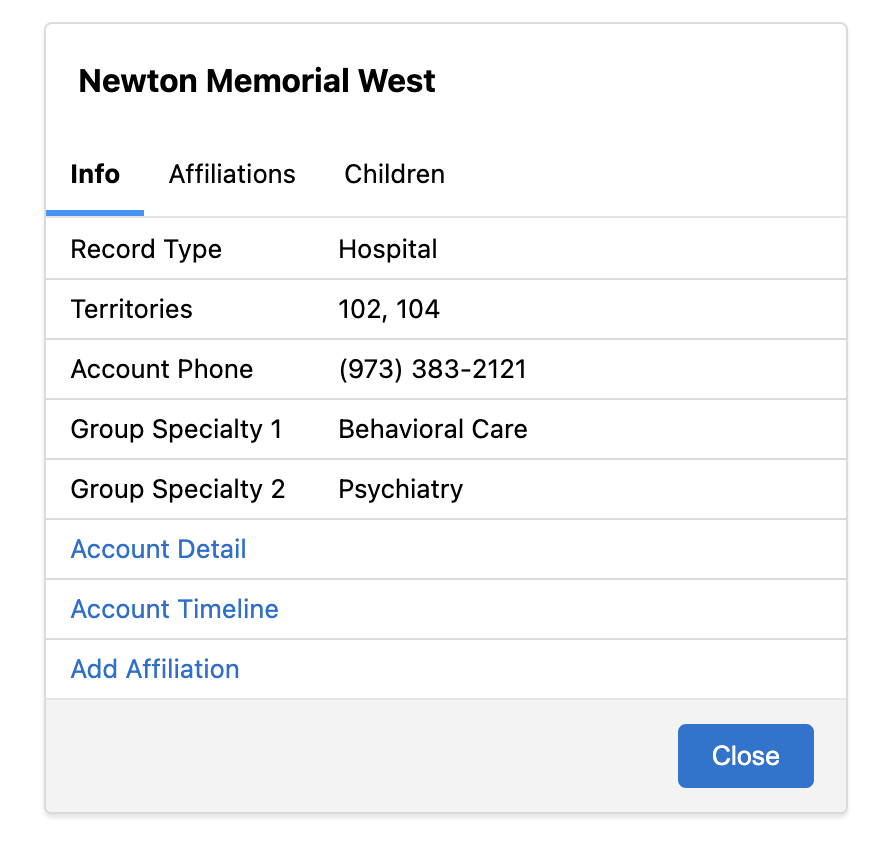
- Affiliations - This tab displays affiliation tiles containing account name, account identifiers, and affiliation influence. Selecting the “View” button centers the hierarchy on the affiliated account. Selecting affiliation tiles reveals more affiliation information and actions.
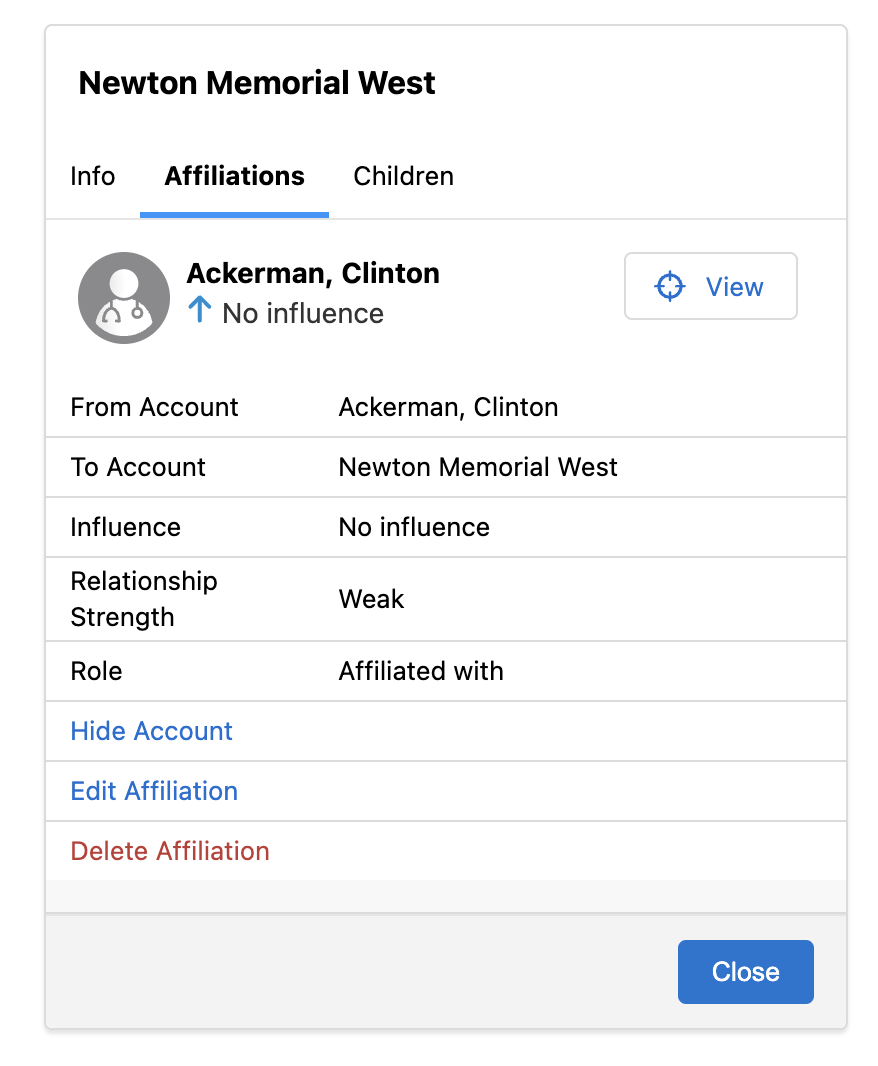
- Children - This tab displays child tiles containing account name, account identifiers. Selecting the “View” button centers the hierarchy on the child account. Selecting on child tiles reveals more account information and actions.
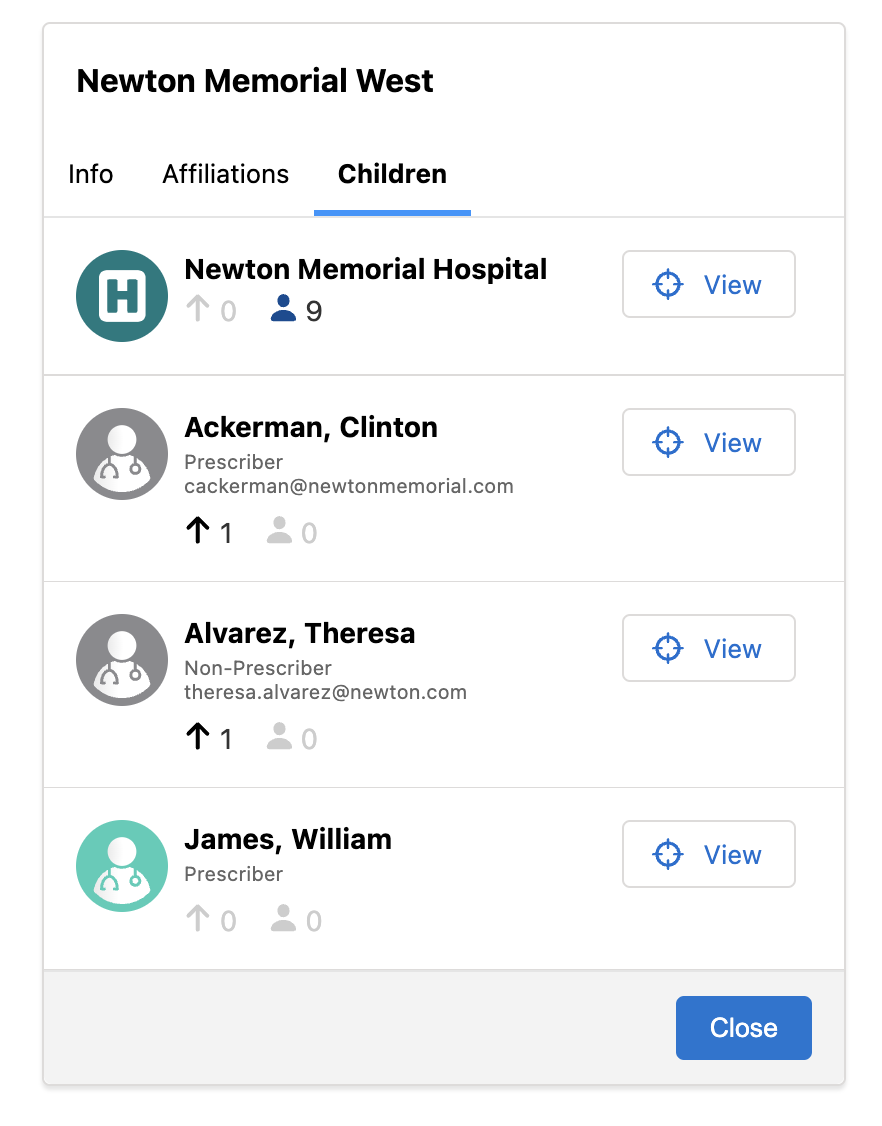
Searching Accounts
The search button located in the top left of the hierarchy allows users to find information for accounts loaded into the Stakeholder Navigator and that are not otherwise filtered out. Enter the desired keywords — for example, enter Clinton to find Clinton Ackerman’s account. Selecting search result tiles reveals more account information and actions.
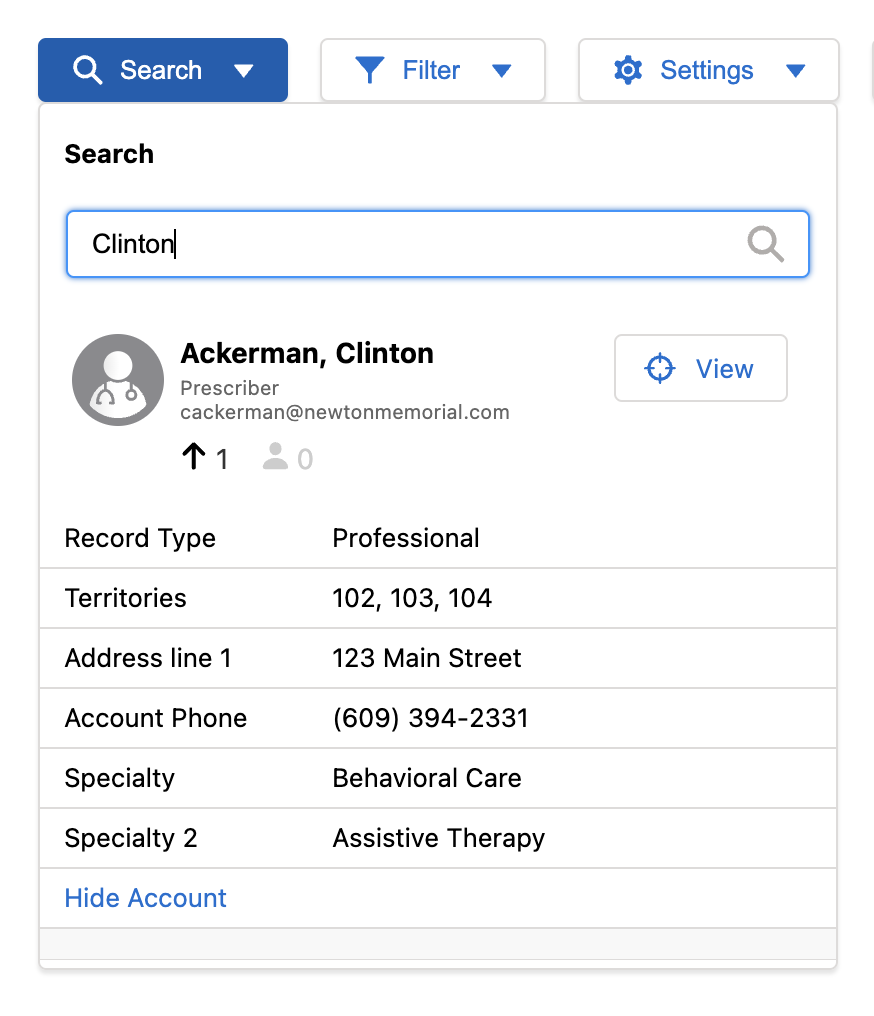
Filtering Accounts
The filter button located in the top left of the hierarchy allows users to filter accounts and affiliation based on chosen criteria. Users can select check boxes to always display Key Stakeholders and to only show accounts that have affiliations. Accounts can also be refined by specialty or by territory. In the Affiliation Filters section, users can refine affiliations by relationship strength, role, and therapeutic area. Users can also specify that only affiliations with influence should display.
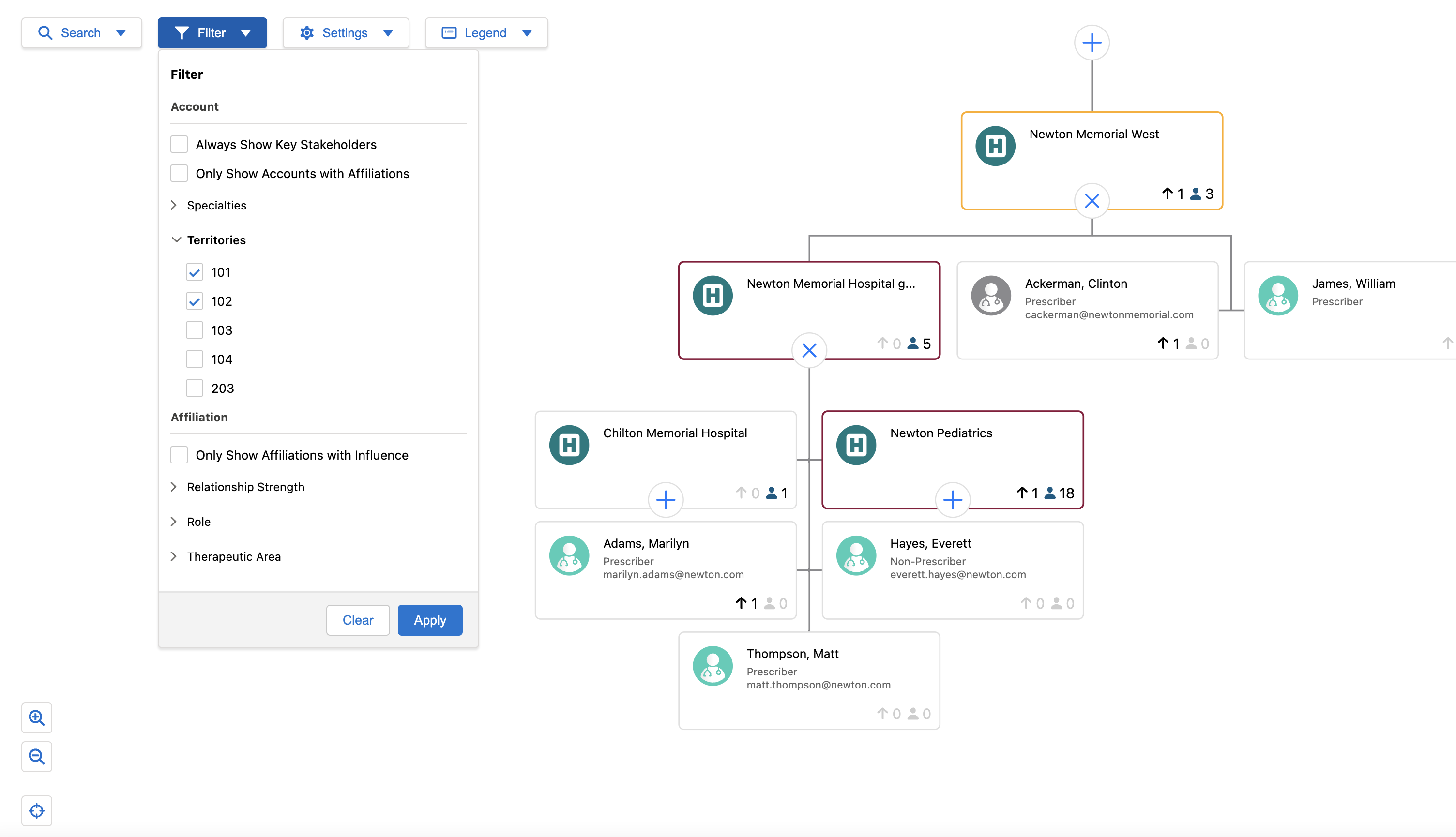
When a filter is applied, all accounts meeting the criteria display along with any accounts that must display for the Stakeholder Navigator to show a link to the root account. For example, if an HCP account meets a user’s filtering criteria but its parent accounts do not, the parent accounts display to show the path from the HCP account to the root account.
The options in the Specialty filter are generated based on the following fields from the accounts displayed in Stakeholder Navigator:
- Specialty_1_vod__c
- Group_Specialty_1_vod__c
- Specialty_2_vod__c
- Group_Specialty_2_vod__c
Specialty filter values display even if the picklist value for the field is set to Inactive.
Toggling Affiliations
Users can choose to display affiliations on the hierarchy in the settings menu. Affiliations display as curved lines on the hierarchy.
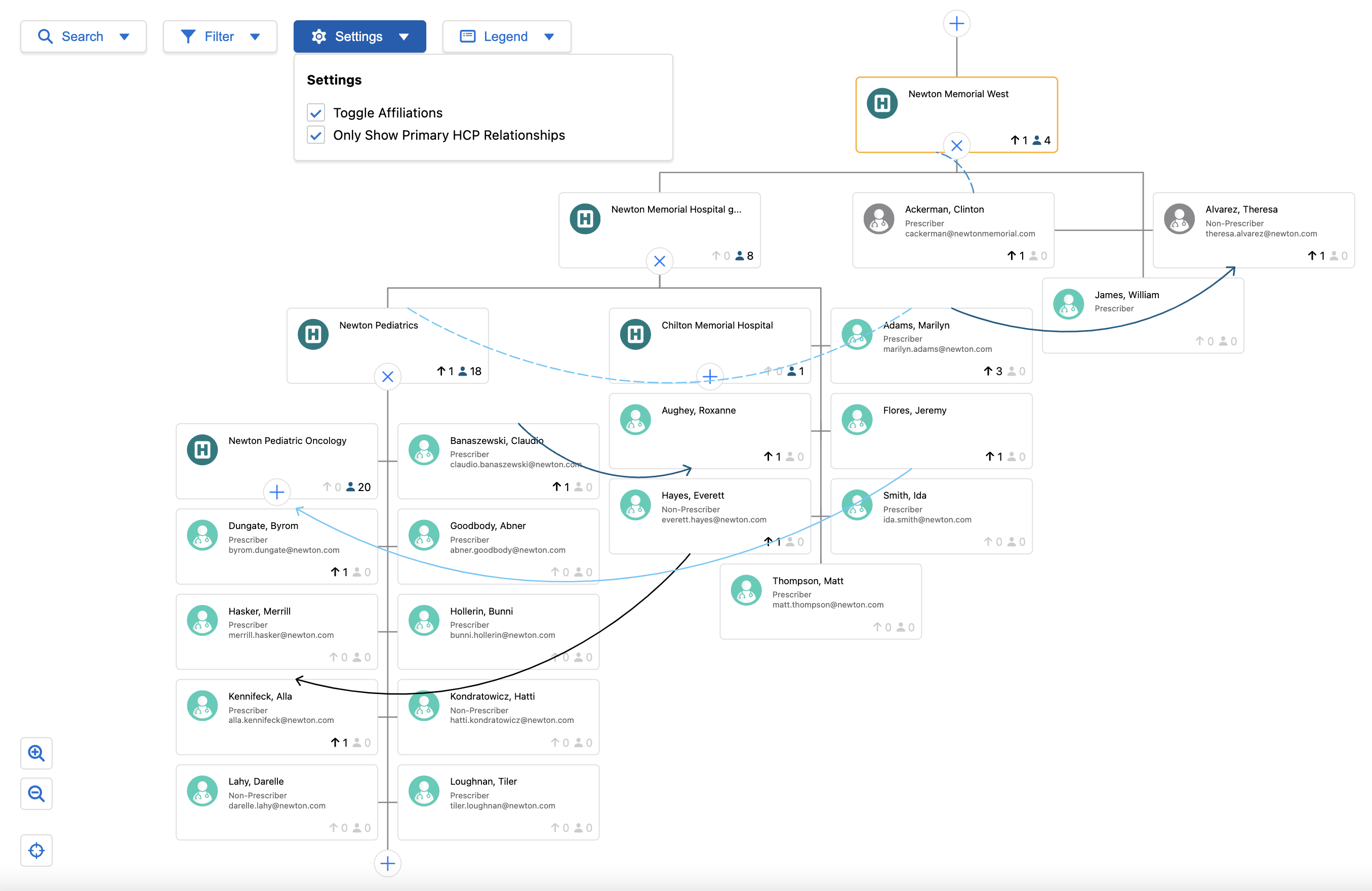
Affiliation influence determines the shape of the line and affiliation strength determines the color.
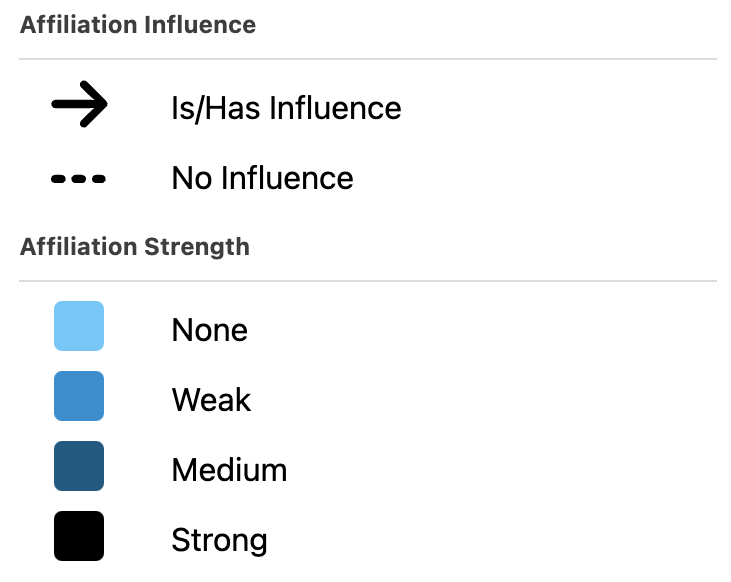
Displaying Out-of-Territory Accounts
Related out-of-territory accounts display along with users’ accounts in the Stakeholder Navigator. This enables users to more accurately manage their accounts, and plan account interactions by providing a full view of their accounts’ professional networks.
Configuration is not needed for this feature.
When a user views an account hierarchy in the stakeholder navigator, any out-of-territory accounts in the account hierarchy display. Out-of-territory accounts are displayed with a gray account icon.
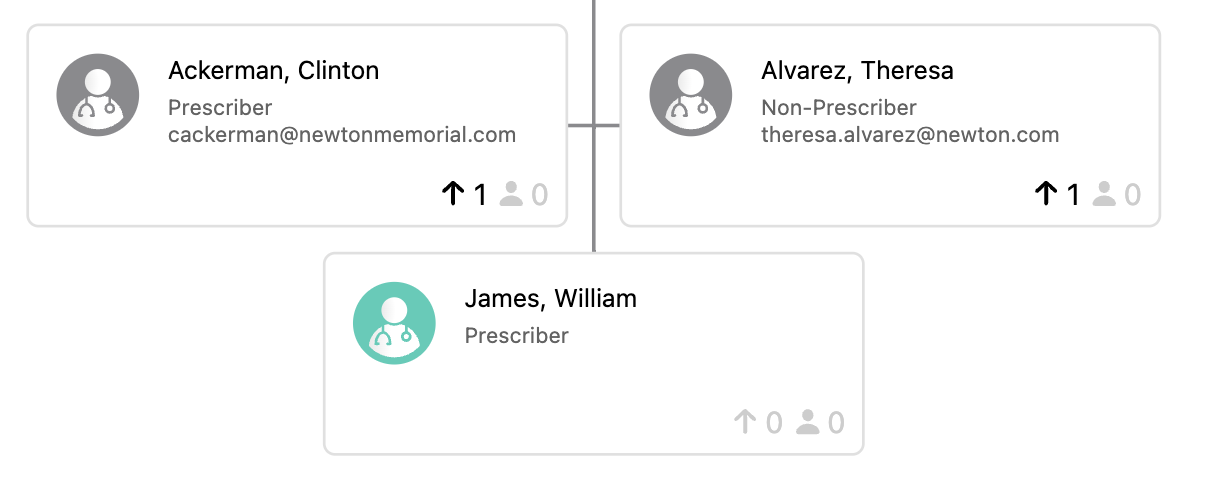
Account details and filters display for out-of-territory accounts in the same way they do for in-territory accounts.
All territories related to at least one of the accounts in the selected account hierarchy display in the territory section of the Filter dropdown, even if the user is not assigned to that territory.
On the iPad platform, out-of-territory accounts display only if they are associated with an in-territory account synced to the iPad.
Only Show Primary HCP Relationships
By default, HCPs only display under their primary parent account, even if they have multiple parent accounts in the selected account hierarchy. To display HCPs accounts under each of their parent accounts, select the Only Show Primary HCP Relationships toggle from the Settings menu. When an HCP has multiple parent accounts in the same hierarchy, an icon displays in the bottom-left corner of the HCP’s account card to indicate their account displays multiple times in the current stakeholder navigator view.
For example, if Dr. Ackerman has three parent accounts in the Newton Memorial Hospital hierarchy, his account displays three times in the stakeholder navigator, under each parent account.
Displaying multiple parent accounts is only available for person accounts. It does not apply to business accounts.

Adding Out-of-Territory Accounts to User Territories
To add an out-of-territory account to one of a users' assigned territories:
-
Select the Add to Territory button. When users add an account to their territory from the stakeholder navigator, an Account_Territory_Loader_vod record is automatically created with the added territory listed in the Territory_To_Add_vod field.
-
Do one of the following:
- If the user is only assigned to one territory, a confirmation message displays. Select Yes to add the account to the territory.
- If the user is assigned to more than one territory, a list of possible territories displays. Select the appropriate territory, then select OK to add the account to the territory.
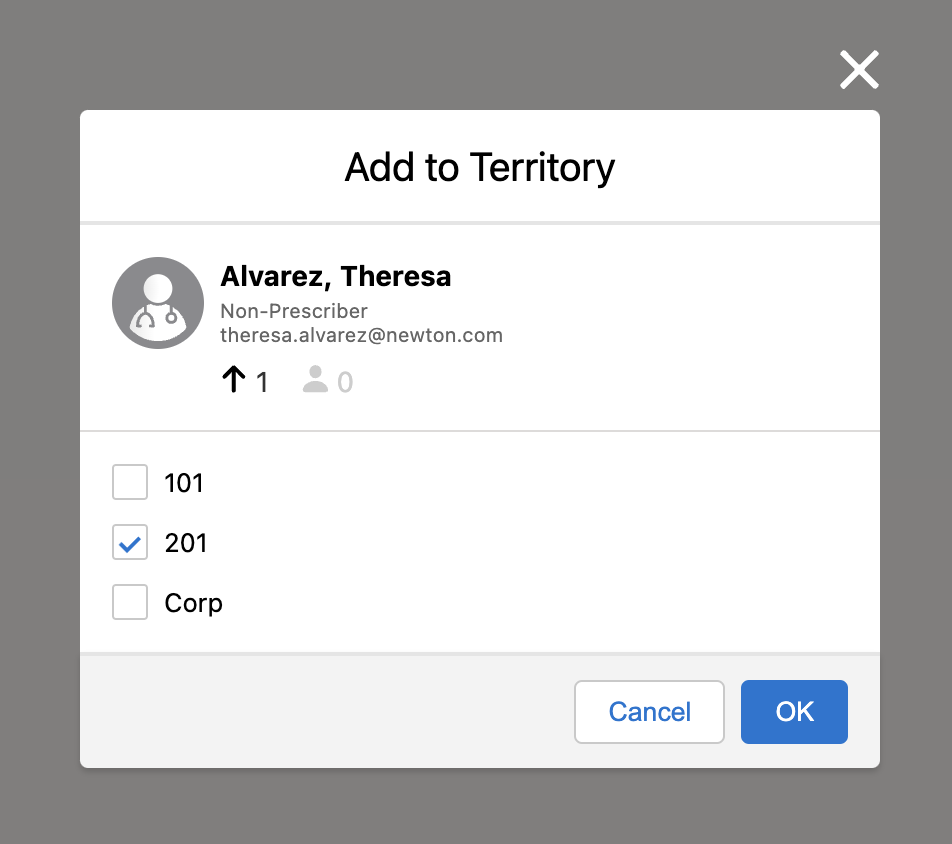
Users must be assigned to at least one territory to use this functionality. If the user is not assigned to any territories, an error message displays when they select Add to Territory.



